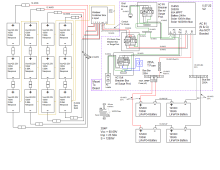tomy2
escape artist
So if I ran a ground wire from the load panel ground straight back to the subpanel new ground busbar, that would cure the floating ground? Thanks again for your insights and patience with us wannabe electricians.How you have it shown would connect it to the house ground when plugged in to the house power. When it isn't plugged in, your ground is floating, so you would want to tie it to a ground somehow (clamp to a grounded rod, or to a house ground, or something).




